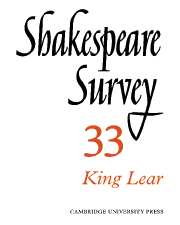Book contents
- Frontmatter
- King Lear: A Retrospect, 1939–79
- Some Conjectures on the Composition of King Lear
- The War in King Lear
- King Lear: Art Upside-Down
- ‘And that’s true too’: King Lear and the Tension of Uncertainty
- The Taming of the Shrew and King Lear: A Structural Comparison
- Medium and Message in As You Like It and King Lear
- Playing King Lear: Donald Sinden talks to J. W. R. Meadowcroft
- Hamlet’s Special Providence
- Antony and Cleopatra: ‘The Time of Universal Peace’
- Patterns of Motion in Antony and Cleopatra
- Theme and Structure in The Winter’s Tale
- Peter Street at the Fortune and the Globe
- English Actors at the Courts of Wolfenbüttel, Brussels and Graz during the Lifetime of Shakespeare
- Shakespeare at Stratford and the National Theatre, 1979
- The Year's Contributions to Shakespearian Study 1 Critical Studies
- 2 Shakespeare’s Life, Times, and Stage
- 3 Textual Studies
- Index
- Plate Section
Medium and Message in As You Like It and King Lear
Published online by Cambridge University Press: 28 March 2007
- Frontmatter
- King Lear: A Retrospect, 1939–79
- Some Conjectures on the Composition of King Lear
- The War in King Lear
- King Lear: Art Upside-Down
- ‘And that’s true too’: King Lear and the Tension of Uncertainty
- The Taming of the Shrew and King Lear: A Structural Comparison
- Medium and Message in As You Like It and King Lear
- Playing King Lear: Donald Sinden talks to J. W. R. Meadowcroft
- Hamlet’s Special Providence
- Antony and Cleopatra: ‘The Time of Universal Peace’
- Patterns of Motion in Antony and Cleopatra
- Theme and Structure in The Winter’s Tale
- Peter Street at the Fortune and the Globe
- English Actors at the Courts of Wolfenbüttel, Brussels and Graz during the Lifetime of Shakespeare
- Shakespeare at Stratford and the National Theatre, 1979
- The Year's Contributions to Shakespearian Study 1 Critical Studies
- 2 Shakespeare’s Life, Times, and Stage
- 3 Textual Studies
- Index
- Plate Section
Summary
It is not surprising that in the constant talk of Shakespeare’s ‘tragic vision’ and ‘comic vision’ the fact that ‘vision’, properly speaking, denotes not what is seen, but the process of seeing, should frequently have been over-looked: but it is much to be regretted that it has. If we are persuaded that King Lear is the bleakest of the tragedies, it is tempting for us to accept it as a testament of bleakness, taking ‘tragedy’ to be the denotation not simply of the artistic medium employed by Shakespeare in this play, but also of the quality of life he is describing. To do so is, of course, to confuse what is seen with the manner in which it is revealed, the object with the medium or filter through which it is viewed. It is more than forty years since Sisson attacked some of the cruder precipitations of this confusion, insisting that for criticism, ‘it is in the main a question of the artistic problems which Shakespeare set himself, not of the problems which life set Shakespeare’ (p. 24). That was well said, but unfortunately Sisson’s admiration of the tragedies led him to a conclusion in which there is a good deal more faith and speculation than objective assessment. The fact that tragedy has nearly always made the greatest theatrical impact tends to blind us to the fact that Shakespeare himself did not consistently regard it as the best medium for what he wanted to say, and that eventually he seems to have found tragic form too constricting, and perhaps even reductive.
- Type
- Chapter
- Information
- Shakespeare Survey , pp. 67 - 80Publisher: Cambridge University PressPrint publication year: 1981



